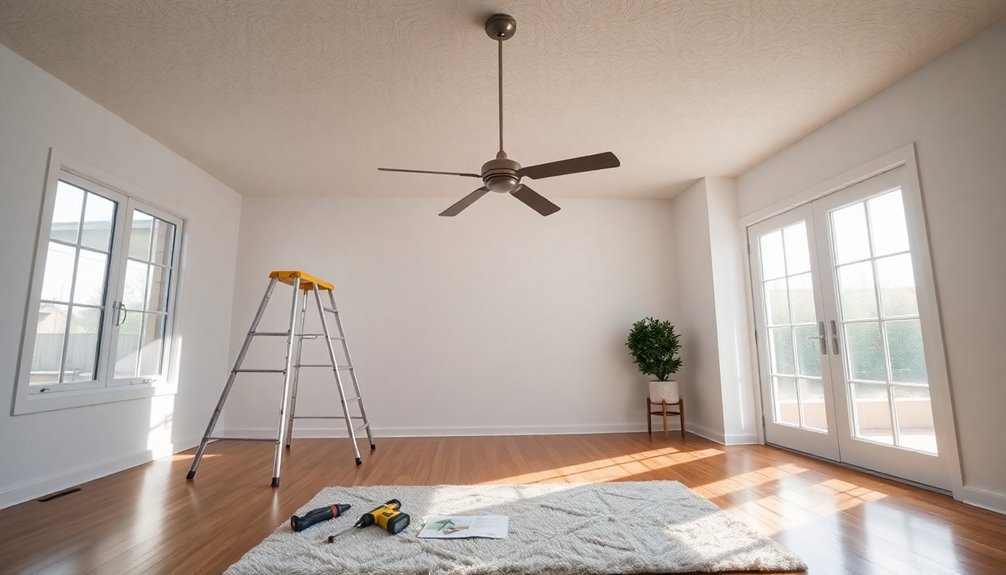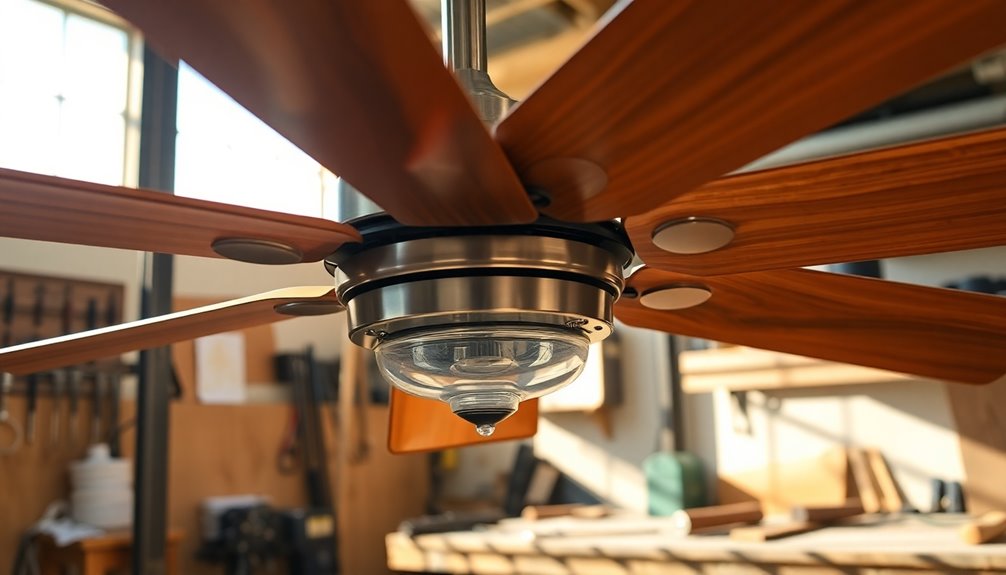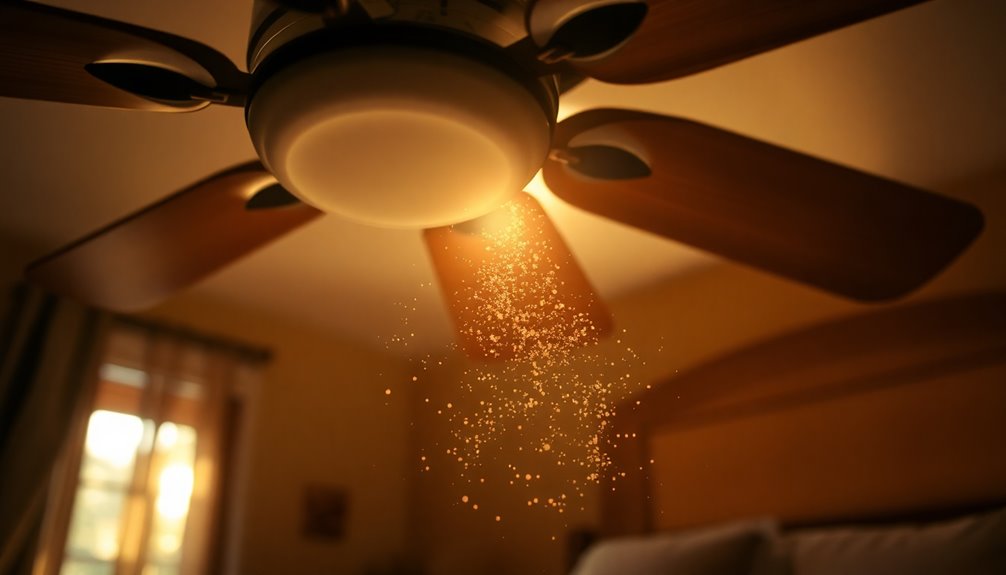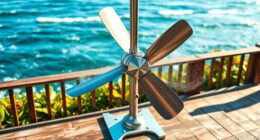If your ceiling fan's making noise, it could be due to several issues. Loose screws or components can cause rattling, while unbalanced blades might make it wobble and create additional sounds. Worn motor bearings often lead to grinding or squeaking, whereas electrical problems may result in humming or buzzing sounds. Improper installation can also contribute to noise issues. Regular maintenance, like tightening screws and cleaning blades, helps reduce these noises. If the sounds persist, you might want to contemplate inspecting further, as there's more to explore about the potential causes and solutions.
Key Takeaways
- Loose components like screws or bolts can cause rattling or clicking noises in ceiling fans.
- Unbalanced blades lead to wobbling, resulting in additional noise during operation.
- Worn motor bearings may produce grinding or squeaking sounds due to increased friction.
- Electrical issues, such as faulty wiring, can generate humming or buzzing noises.
- Improper installation may result in rattling noises from misaligned or insecurely mounted fans.
Common Causes of Noise

Ceiling fan noise can be quite bothersome, and understanding its common causes is key to resolving the issue. One of the most frequent culprits is loose screws, bolts, or fasteners. When these components aren't secured properly, they can create vibrations that result in rattling or clanking noises.
Another common cause is an unbalanced fan; if the weight distribution across the blades is uneven, it can cause the fan to wobble, leading to additional noise during operation.
Worn-out or dirty motor bearings may also contribute to grinding or squeaking noises, as increased friction occurs when the fan is in motion. Additionally, electrical issues, such as faulty wiring or capacitor problems, can produce humming or buzzing sounds that signal potential malfunctions.
Finally, improper installation, including misalignment or insecure mounting, can generate rattling or clicking sounds, further disrupting your peace. Regular maintenance can prevent dangerous situations and help keep your ceiling fan operating quietly and safely.
Types of Ceiling Fan Noises

Various types of ceiling fan noises can indicate different issues, and recognizing them is crucial for effective troubleshooting. A clicking noise often arises from loose blades, bent blade arms, or a loose light fixture. Such issues create a repetitive sound that can be quite annoying.
If you hear a humming or buzzing sound, it typically points to electrical problems related to the motor or wiring, which you should investigate promptly to avoid complications.
A rubbing noise usually suggests mechanical issues, often due to misalignment or lack of lubrication, causing parts to rub against each other. Meanwhile, a rattling noise often results from loose screws or components, indicating installation problems or normal wear and tear that needs addressing.
It's important to check for loose components, as this can lead to further issues if left unattended.
In some cases, you might hear crackling or sizzling noises, which are serious and signal potential electrical hazards, requiring immediate attention. These could hint at a malfunctioning capacitor or other electrical failures, so don't ignore these signs of damage.
Diagnosing the Noise Issue

To diagnose the noise from your ceiling fan, start by listening closely to identify the type of sound, like clicking or humming.
Next, inspect the components thoroughly, checking for loose parts and ensuring the blades are balanced.
These steps will help you pinpoint the issue and find a solution quickly.
Identify Noise Type
When your ceiling fan starts making unusual sounds, identifying the type of noise is essential for effective troubleshooting. Different noises can point to specific issues.
For instance, a clicking noise often indicates loose parts, such as blades or bent blade arms. It could also be due to an unsecured light fixture, so you'll want to inspect these components closely.
Humming or buzzing sounds are typically linked to electrical problems, suggesting that you should investigate the motor or wiring immediately to avoid further complications.
If you hear a squeaking noise, it's usually due to worn bearings, which might require lubrication or replacement.
Rubbing noises may signal misalignment of the fan components, indicating that adjustments or oiling might be necessary to restore smooth operation.
However, if you hear crackling or sizzling noises, take that seriously; these can indicate electrical hazards that demand urgent attention to guarantee your safety and the fan's proper function.
Inspect Components Thoroughly
During your inspection of the ceiling fan, pay close attention to the components that could be causing the noise. Start by listening closely while the fan operates. If you hear a ceiling fan making clicking sounds, it might indicate loose parts.
Inspect components thoroughly, focusing on the fan blades for any visible damage, warping, or dirt buildup that can create imbalance and increase noise.
Next, check all screws and fasteners, especially those securing the blades, motor, and light fixture. Be certain to tighten the screws, as loose components are often the source of rattling sounds.
Examine the motor housing and mounting; any signs of misalignment or wear can lead to vibrations and additional noise if not secured properly.
Don't overlook electrical connections. Verify all wiring is intact and properly connected. Loose or damaged wires can result in buzzing or humming sounds, especially if the noise is consistent.
Fixing Noisy Ceiling Fans

Noise from ceiling fans can be incredibly frustrating, but addressing the issue is often straightforward.
Start by identifying the type of noise your fan is making. If you hear clicking sounds, turn off the fan and carefully tighten any loose screws on the blades and light fixtures to eliminate vibrations.
For humming or buzzing noises, inspect the motor for defects and verify all electrical connections are secure and properly installed.
If you're dealing with rubbing noises, check for misalignment of components and apply lubrication to the motor bearings to reduce friction. You might also want to inspect the canopy and mounting bracket for tightness. Secure any loose fasteners to prevent rattling sounds.
Finally, if wobbling persists despite your balancing efforts, consider using a ceiling fan balancing kit. This can help you adjust the blade weight distribution effectively.
Maintenance Tips for Quiet Operation

To keep your ceiling fan running quietly, you'll want to focus on regular maintenance.
Start by tightening any loose screws and bolts, as they can cause annoying rattles.
Additionally, make sure to clean and lubricate the fan parts to prevent wear and tear that leads to unwanted noise.
Regularly Tighten Components
Ensuring your ceiling fan operates quietly starts with a simple yet vital maintenance step: regularly tightening its components. By taking the time to regularly tighten screws and bolts on the fan blades, motor assembly, and mounting bracket, you can effectively prevent rattling and noise that may arise from loose components.
Don't forget to inspect and secure all light fixture screws, as they can contribute to vibrations and clicking sounds during operation.
Also, make sure to check the canopy screws; tight screws can eliminate rattling against the ceiling, a common source of noise.
Additionally, it's important to perform routine maintenance by checking the downrod connection to the ceiling. A loose connection can lead to wobbling and unnecessary noise.
To keep your fan in top shape, schedule regular inspections to tighten any components that may have become loose over time. This proactive measure not only helps maintain quiet operation but also extends the lifespan of your ceiling fan.
Clean and Lubricate
After tightening all components, the next step in maintaining a quiet ceiling fan is to clean and lubricate it regularly. Dust accumulation on the fan blades can disrupt balance and create noise, so it's crucial to clean your fan. Use a lightly damp rag to wipe down both the blades and motor housing, making sure you remove any debris that may affect performance.
To keep your fan running smoothly, consider these essential tips:
- Regularly cleaning the fan blades helps prevent dust buildup.
- Carefully inspect the motor for oil levels; if there's insufficient lubrication, add 1 to 2 ounces of the manufacturer-recommended fan oil.
- If your fan has a light, confirm it's free of dust, too, to maintain overall cleanliness.
Lubricating the motor bearings annually reduces friction and wear, minimizing grinding or squeaking sounds.
After cleaning and lubricating, always test the fan to verify that the noise levels have decreased, and it operates smoothly.
Inspect for Damage
Regular inspections are key to maintaining a quiet ceiling fan. When your ceiling fan is running, it's crucial to examine the fan blades for any signs of warping or damage. Uneven blades can cause the fan to be noisy and create an imbalance during operation.
Next, inspect the motor housing and mounting bracket for visible damage or wear, as these issues can lead to vibrations and rattling sounds.
Don't forget to check the light fixture and its attachments. Loose screws or components can create clicking noises when the fan is in motion. Additionally, inspect the canopy to make certain it's securely fastened. A loose canopy can rattle against the ceiling, causing distracting noises.
Pay attention to the bearings and other moving parts. Look for signs of wear, as damaged or dry components can generate grinding or squeaking sounds during operation.
When to Call a Professional

When your ceiling fan starts making persistent noise despite your best efforts to maintain it, it's time to contemplate calling a professional. Ignoring those unusual sounds could indicate a deeper problem that requires expert attention.
If you hear loud humming, squeaking, or grinding noises, don't overlook them. These could signal electrical or mechanical failures that only a trained technician can properly diagnose and repair.
Consider reaching out for help if you notice:
- Flickering lights when the fan is on, hinting at electrical issues
- Visible damage like bent blades or a cracked motor housing
- Ongoing noise from improper mounting that just won't go away
If your ceiling fan makes these concerning sounds, it's essential to act quickly. Signs of a problem with the motor or other components can escalate into significant hazards if left unattended.
Professional customer service guarantees that any repairs won't only resolve the noise but also enhance the fan's performance and safety. Don't hesitate to enlist an expert when your ceiling fan's disturbances signal trouble; it'll save you time, money, and potential dangers in the long run.
Preventing Future Noise Problems

To keep your ceiling fan running smoothly and quietly, implementing a proactive maintenance routine can make a significant difference.
Start by regularly cleaning your fan to remove dust and debris, as buildup can lead to imbalance and increased noise levels. Make certain to tighten all screws and bolts periodically; loose components are a common source of rattling and clicking sounds that can disrupt your peace.
Lubricating the motor bearings at least once a year is essential to reduce friction, minimizing any squeaking or grinding noises during operation.
Regularly inspect the alignment and balance of the blades. Unbalanced blades not only cause wobbling but also contribute to annoying noise and affect overall performance.
If you notice any noise issues, address them promptly. Ignoring minor sounds can lead to larger mechanical problems over time, costing you more in repairs. Additionally, be aware that maintaining a clean and safe environment around your fan can prevent fire hazards that might arise from nearby combustibles.
Frequently Asked Questions
How Do I Stop My Ceiling Fan From Making Noise?
To stop your ceiling fan from making noise, start by tightening all screws and bolts to eliminate rattling.
Next, clean the blades and motor housing to remove dust that might disrupt balance.
Lubricate the motor bearings annually to reduce friction.
You should also inspect and balance the fan blades for even weight distribution.
Finally, guarantee the installation is secure and properly aligned to prevent any unnecessary noise during operation.
Should I Be Worried if My Fan Is Making Noise?
When your ceiling fan's making noise, it's like hearing a warning siren in the distance; you shouldn't ignore it.
You should definitely be concerned, as those sounds can indicate underlying issues that might worsen if left unchecked. Loose parts, electrical problems, or worn-out bearings could lead to bigger problems down the line.
It's best to investigate the source of the noise soon to guarantee your fan operates safely and efficiently.
What Is the Reason for Sound in a Ceiling Fan?
When you hear sound coming from your ceiling fan, it typically signals an underlying issue.
It could be loose screws or unbalanced blades causing vibrations. Sometimes, a dirty motor or worn components lead to humming or grinding. Dust accumulation can disrupt smooth operation, increasing noise levels.
Additionally, if the fan's installation is poor or misaligned, it might rattle or click. Addressing these issues can help restore your fan's quiet, efficient operation.
How Do I Reduce the Noise of My Fan?
To reduce the noise of your fan, start by tightening all screws and bolts to eliminate rattling.
Next, clean the blades and motor housing to maintain balance.
Lubricate the motor bearings annually to minimize friction.
Using a ceiling fan balancing kit can help guarantee the blades are evenly weighted.
Finally, check for loose light fixtures or canopy mounts and secure them to prevent additional vibrations and rattling sounds during operation.
Conclusion
To sum up, if your ceiling fan's making noise, don't ignore it; investigate it. Identify the cause, address the issue, and maintain it regularly. Whether it's tightening loose screws, balancing the blades, or simply cleaning it, you can enjoy a quieter environment. Remember, staying proactive not only enhances your comfort but also prolongs your fan's life. Keep your space serene, keep the noise at bay, and keep your ceiling fan running smoothly for years to come.









